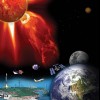A geomagnetic storm recently caused some unusual aurora sightings on Earth. The storm is a result of solar eruptions strong enough to disturb
Earth’s magnetosphere. The magnetosphere usually protects us from solarwinds so what made this disturbance different?
Cause and Effect
A solar wind shock wave or similar disturbance in space can cause a geomagnetic storm on Earth by interacting with the magnetic field. A coronal mass ejection (CME) from the sun releases electrons and protons in the form of plasma at high speeds into the magnetosphere of Earth. A fast-moving solar wind with a magnetic field oriented south, like the
most recent one, is more likely to cause a high-level storm.
The magnetic flux causes increased energy to transfer into Earth’s magnetosphere. And, depending on the scale and orientation of the disruption, a geomagnetic storm can result in unusual aurora sightings as well as disruptions of radio signals and magnetic compass navigation.
The Perfect Magnetic Storm
The first observation of a geomagnetic storm occurred in 1806 when
Alexander von Humboldt noticed erratic behavior in his compass at the same time as an auroral event. Humboldt was likely the first person to coin the term ‘magnetic storm.’ Since 1806, numerous geomagnetic storms have occurred and caused disruptions or auroral events on Earth. In 1859, we experienced the largest geomagnetic storm ever recorded. The Solar Storm of 1859 or the
Carrington Event caused aurora sightings as far south as Hawaii.
How to Predict and Measure a Geomagnetic Storm
Scientists at the
Space Weather Prediction Center can predict a geomagnetic storm by observing solar flares and bursts on the Sun’s surface. They can determine how severe a storm will be by how fast it travels and what direction it faces. The Solar Storm of 1859 reached Earth in 18 hours, the fastest storm yet recorded. Usually, geomagnetic storms reach Earth within 2 to 3 days of ejecting from the Sun.
Geomagnetic storms are measured on a 5-point scale. The most recent storm occurred on June 22, 2015 and lasted a few days. It ranked G4 on the scale which is the second-highest severity ranking. If you’re interested in magnetic storms and their effects, you can measure changes in the Earth’s magnetic field at home using a
magnetometer. Magnetometers can help predict and measure the severity of a geomagnetic storm. Have you ever experienced the effects a magnetic storm?

